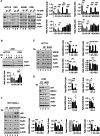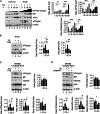Mutant p53 upregulates HDAC6 to resist ER stress and facilitates Ku70 deacetylation, which prevents its degradation and mitigates DNA damage in colon cancer cells
- PMID: 40210861
- PMCID: PMC11985993
- DOI: 10.1038/s41420-025-02433-9
Mutant p53 upregulates HDAC6 to resist ER stress and facilitates Ku70 deacetylation, which prevents its degradation and mitigates DNA damage in colon cancer cells
Abstract
Cancer cells employ interconnected mechanisms to withstand intrinsic and extrinsic stress, with mutant p53 (mutp53) playing a key role in bolstering resistance to endoplasmic reticulum (ER) stress. In this study, we further investigated this phenomenon, focusing on the DNA damage triggered by ER stress. Our findings indicate that mutp53 mitigates ER stress-induced DNA damage by sustaining high levels of Ku70, a critical protein in DNA repair via the non-homologous end joining (NHEJ) pathway, which functions alongside Ku80. HDAC6 upregulation emerged as a crucial driver of this response. HDAC6 deacetylates Ku70, promoting its nuclear localization and protecting it from degradation. This mechanism ensures continuous activity of the NHEJ repair pathway, allowing mutp53-expressing cells to better manage DNA damage from ER stress, thus contributing to the genomic instability characteristic of cancer progression. Furthermore, HDAC6 maintains the activation of the ATF6 branch of the unfolded protein response (UPR), enhancing the ability of mutp53 cells to resist ER stress, as ATF6 supports cellular adaptation to misfolded proteins and stressful conditions. Since HDAC6 is central to this enhanced stress resistance and DNA repair, targeting it could disrupt these protective mechanisms, increasing the vulnerability of mutp53 cancer cells to ER stress and inhibiting cancer progression.
© 2025. The Author(s).
Conflict of interest statement
Competing interests: The authors declare no competing interests. Ethics approval: Ethics approval was not needed, as this study does not involve patients or animals.
Figures






References
-
- Gonzalez-Quiroz M, Blondel A, Sagredo A, Hetz C, Chevet E, Pedeux R. When endoplasmic reticulum proteostasis meets the DNA damage response. Trends Cell Biol. 2020;30:881–91. - PubMed
-
- Groelly FJ, Fawkes M, Dagg RA, Blackford AN, Tarsounas M. Targeting DNA damage response pathways in cancer. Nat Rev Cancer. 2023;23:78–94. - PubMed
Grants and funding
LinkOut - more resources
Full Text Sources
Research Materials
Miscellaneous

